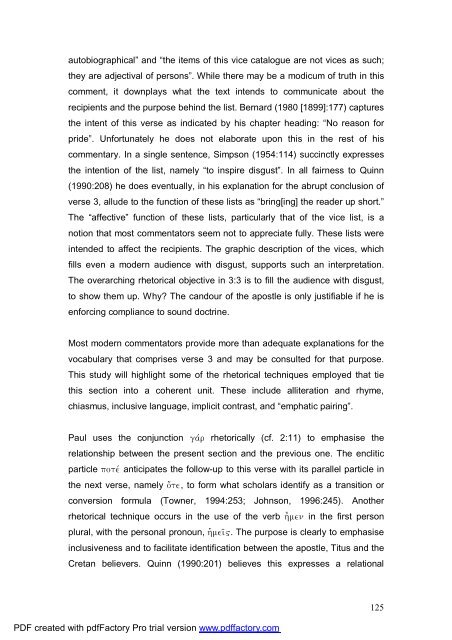A Text centred rhetorical analysis of Paul's Letter to Titus
A Text centred rhetorical analysis of Paul's Letter to Titus
A Text centred rhetorical analysis of Paul's Letter to Titus
Create successful ePaper yourself
Turn your PDF publications into a flip-book with our unique Google optimized e-Paper software.
au<strong>to</strong>biographical” and “the items <strong>of</strong> this vice catalogue are not vices as such;<br />
they are adjectival <strong>of</strong> persons”. While there may be a modicum <strong>of</strong> truth in this<br />
comment, it downplays what the text intends <strong>to</strong> communicate about the<br />
recipients and the purpose behind the list. Bernard (1980 [1899]:177) captures<br />
the intent <strong>of</strong> this verse as indicated by his chapter heading: “No reason for<br />
pride”. Unfortunately he does not elaborate upon this in the rest <strong>of</strong> his<br />
commentary. In a single sentence, Simpson (1954:114) succinctly expresses<br />
the intention <strong>of</strong> the list, namely “<strong>to</strong> inspire disgust”. In all fairness <strong>to</strong> Quinn<br />
(1990:208) he does eventually, in his explanation for the abrupt conclusion <strong>of</strong><br />
verse 3, allude <strong>to</strong> the function <strong>of</strong> these lists as “bring[ing] the reader up short.”<br />
The “affective” function <strong>of</strong> these lists, particularly that <strong>of</strong> the vice list, is a<br />
notion that most commenta<strong>to</strong>rs seem not <strong>to</strong> appreciate fully. These lists were<br />
intended <strong>to</strong> affect the recipients. The graphic description <strong>of</strong> the vices, which<br />
fills even a modern audience with disgust, supports such an interpretation.<br />
The overarching <strong>rhe<strong>to</strong>rical</strong> objective in 3:3 is <strong>to</strong> fill the audience with disgust,<br />
<strong>to</strong> show them up. Why? The candour <strong>of</strong> the apostle is only justifiable if he is<br />
enforcing compliance <strong>to</strong> sound doctrine.<br />
Most modern commenta<strong>to</strong>rs provide more than adequate explanations for the<br />
vocabulary that comprises verse 3 and may be consulted for that purpose.<br />
This study will highlight some <strong>of</strong> the <strong>rhe<strong>to</strong>rical</strong> techniques employed that tie<br />
this section in<strong>to</strong> a coherent unit. These include alliteration and rhyme,<br />
chiasmus, inclusive language, implicit contrast, and “emphatic pairing”.<br />
Paul uses the conjunction gavr <strong>rhe<strong>to</strong>rical</strong>ly (cf. 2:11) <strong>to</strong> emphasise the<br />
relationship between the present section and the previous one. The enclitic<br />
particle potev anticipates the follow-up <strong>to</strong> this verse with its parallel particle in<br />
the next verse, namely o{te, <strong>to</strong> form what scholars identify as a transition or<br />
conversion formula (Towner, 1994:253; Johnson, 1996:245). Another<br />
<strong>rhe<strong>to</strong>rical</strong> technique occurs in the use <strong>of</strong> the verb h\men in the first person<br />
plural, with the personal pronoun, hJmei`". The purpose is clearly <strong>to</strong> emphasise<br />
inclusiveness and <strong>to</strong> facilitate identification between the apostle, <strong>Titus</strong> and the<br />
Cretan believers. Quinn (1990:201) believes this expresses a relational<br />
PDF created with pdfFac<strong>to</strong>ry Pro trial version www.pdffac<strong>to</strong>ry.com<br />
125

















